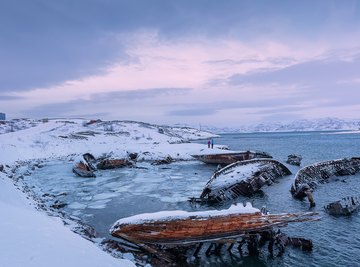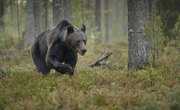
Tundra regions make up some of the coldest regions on Earth. The word "tundra" derives from the Finnish word for “treeless plain,” which fits a broad description of the tundra biome. The tundra regions tend to range in a circuit from south of the Arctic ice caps. Tundra climates can be found in the high Arctic or at high elevations in mountains outside the Arctic. The climate of the tundra maintains a generally cold temperature range, notable for its wind and its low precipitation.
TL;DR (Too Long; Didn't Read)
The tundra climate is a very dry and bitterly cold climate found chiefly in the Arctic regions or at high alpine locations. The tundra climate offers a brief growing season that encourages low species diversity. The animals and plants of the tundra biome have adapted to survive the harsh climate.
Tundra Temperature Range
The Arctic tundra temperature ranges from 10 to 20 degrees Fahrenheit. Winter temperatures can reach -30 to -50 degrees Fahrenheit. Some areas such as Iceland experience slightly warmer temperatures due to their proximity to the Gulf Stream. Bitter tundra temperatures in winter last from six to 10 months, leading to permanently frozen subsurface ground called permafrost. The region can experience a brief summer, with cool to relatively warm tundra temperatures up to 50 degrees Fahrenheit.
Precipitation in the Tundra
Despite its typically snowy appearance, the tundra in fact receives very little precipitation. It exists essentially as a frigid desert. The average yearly precipitation ranges from 6 to 10 inches. Precipitation falls as snow in the winter months, and in summer it exists as either rain or fog. The permafrost and bogs store water in the tundra.
Tundra Climate Regions
Tundra climates can be found mostly in the northern hemisphere at high latitudes. Subregions delineate based on their latitude: high Arctic tundra, middle Arctic tundra and low Arctic tundra. The more extreme climate of the high Arctic tundra ensures a stark landscape peppered across islands, with varied lichen and moss species. The middle Arctic tundra experiences a pattern of freezing and thawing, with enough moisture to encourage sphagnum moss. The low Arctic tundra hosts many more plant species such as shrubs, berries and smaller trees, including evergreens, and abuts boreal forest climates.
Another area of tundra climate, alpine tundra, exists at high altitudes in the northern hemisphere. While the seasonal status of alpine tundra differs from the Arctic tundra regions, alpine tundra climate nevertheless resembles the harshness of the far north. At high elevations, trees become stunted in the cold with little soil. Heaths and forbs flourish in this environment. The alpine tundra areas exist above the tree line of mountains. Alpine tundra regions experience a much longer growing season than Arctic tundra regions due to their lower latitude.
The Tundra Biome
The tundra biome is considered the world’s coldest biome. The growing season of the tundra tends to range up to 60 days. In the high latitudes in summer the sun remains in the sky at every hour. Because of the short growing season, few trees exist in the tundra. Dominant plant species include mosses, lichens and shrubs. Vegetation in the northern limits of the tundra tends to be smaller and vegetation in the southern portion tends to be larger. The most extreme, polar northern areas experience essentially no vegetation. The presences or absence of surface water encourages microclimates for plant life. Approximately 1,700 plant species live within the Arctic and subarctic tundra. Soils offer low nutrients, and the permafrost tends to contain mainly gravel. Flowers often face the sun (this is a quality known as "heliotropic") to gain heat. Plants tend to rely upon wind for seed dispersal due to the prevalent tundra winds. In general the tundra biome lacks much species diversity.
Adaptations to the Tundra Climate
Animals and plants residing in the tundra climate require special adaptations in order to survive. Animals tend toward large, stocky frames with thick insulation. Layers of fat and fur or feathers help protect animals from the bitter cold. Winter plumage and coats tends to be white like snow, whereas summer coloring tends toward brown. Because of permafrost, few burrowing animals reside in the tundra climate. The lack of winter food also discourages hibernation. Animals must therefore be active in winter or migrate. Birds tend to boast long wingspans. There are essentially no cold-blooded vertebrates due to the extreme cold temperatures, but insects do subsist in the tundra ecosystem. Most insect species in the tundra tend to be aquatic. Plants adapt to the savage cold and harsh wind via low height and clumping together. The tundra’s few trees remain stunted as an adaptation to the protective insulation of snow on the ground. Plants also photosynthesize even in the low light and cold temperatures.
Notable Tundra Animal Species
While animal diversity trends lower in the tundra ecosystem, notable permanent and migratory species exist. The lemming represents the chief herbivore of the tundra. The snowy owl reigns as a partially migratory predator that responds to lemming population fluctuations. Other Arctic tundra animals include the iconic polar bears, Arctic foxes, gray wolves, voles, Arctic hares, squirrels and snow geese. Seals, walrus and beluga whales ply the arctic waters. The tundra draws migratory animals such as caribou and waterfowl, particularly for breeding seasons. When colder weather arrives, these animals return south to avoid the harshest conditions. Migratory birds include sandpipers, gulls, loons, ravens and terns, among others. Tundra fish species include salmon, trout and cod. Marmots, sheep, goats and many species of birds reside in alpine tundra regions. These alpine animals subsist on insects and plants in warmer areas. Typical insect species include bumblebees, moths, flies, mosquitos and grasshoppers.
Challenges for the Tundra Climate
Climate change rapidly alters the tundra. Animals adapted to the harsh climate must compete with animals moving north due to warmer temperatures. Rapid melting of permafrost in the Arctic threatens to accelerate climate change as well. Because permafrost stores a large percentage of carbon, if released in the atmosphere due to melting, it threatens to accelerate the greenhouse effect with additional carbon dioxide or methane. And as the permafrost melts, new populations of animals will continue to shift into the region to consume the water and plants. Plants that could not thrive in the tundra climate can now grow, changing the tundra ecosystem. Warmer Arctic temperatures mean that freezing occurs much later in the season. Additional challenges to the tundra climate include human encroachment for oil drilling and pollution. The tundra takes longer to recover from vast changes than many regions. These processes are occurring so quickly that the delicate tundra ecosystem may not survive. Scientists continue to learn from the tundra climate via studying its permafrost, which preserves evidence of past climate fluctuations. As scientists learn more about how climate change affects the tundra climate, conserving the tundra ecosystem can help ensure the protection of this intriguing biome.
References
About the Author
J. Dianne Dotson is a science writer with a degree in zoology/ecology and evolutionary biology. She spent nine years working in laboratory and clinical research. A lifelong writer, Dianne is also a content manager and science fiction and fantasy novelist. Dianne features science as well as writing topics on her website, jdiannedotson.com.
